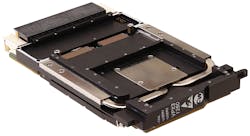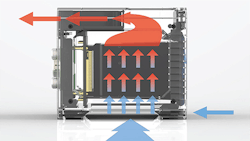What a crazy 2020 we had, and 2021 isn’t exactly off to a great start! If you’re like me, you’re looking forward to a new administration and trying to sort out when you might get your COVID-19 vaccination. Fortunately, life in the standards business is much better!
The VITA community hasn’t experienced any significant changes in business. Standards are still being developed, and new products and design wins are being announced at a normal pace. VITA standards meetings since last March have been virtual and well-attended while also very productive.
Members find it easier to participate, especially when all parties are virtual. The face-to-face aspect is still greatly missed in maintaining existing friendships and developing new relationships. Some things are just difficult to do in a virtual environment, despite the clever things that virtual-event tool developers are innovating to engage participants.
Standard Bearers
We were able to get eight standards through the VITA/ANSI process in 2020, including ANSI/VITA 46.30 and VITA 46.31, which enabled extending the data rate of VPX to the next level of at least 25 Gbaud for protocols such as 100GBASE-KR4 Ethernet and PCIe Gen 4. The higher-data-rate connectors defined in these standards are intermateable to legacy VITA 46.0 connectors and follow the same form factor. The working groups have been focused on this problem for several years (Fig. 1).
Another challenge met in 2020 was the release of additional ANSI/VITA 67 coaxial interconnect on VPX standards. These standards enable various configurations to support RF connections to a VPX module, extending the use to some interesting applications utilizing RF I/O. This work complements the configurations defined under various VITA 66 VPX optical standards.
A key focus of much of those efforts is trying to strike a balance between flexibility in design options with a push to converge on well-defined configurations. The building-block approach taken in these standards optimizes the balance. The working group focused on fewer, more common standard modules to bring economies of scale, increased interoperability, shorter development cycles, and reduced costs into consideration.
Rounding out 2020 activities was a significant update to the ANS/VITA 48 standards for Ruggedized Enhanced Design Implementation (REDI) mechanical implementations for 3U and 6U in various cooling schemes (Fig. 2). The working group extended the standards to include new air- and liquid-cooling schemes introduced the past few years.
Engaging SOSA
Much of the current activity at VITA is driven by user requirements coming out of the SOSA Consortium. They have adopted many of the VPX standards in their documentation. The SOSA Consortium is pushing the envelope on performance and optical/RF connectivity for high-performance embedded computing using VPX as the hardware foundation.
As open standards gain momentum in such demanding applications, the performance envelope will continue to be pushed, leading to more standards to meet these needs. For VITA technology, this means higher data rates, denser optical and RF connectivity, and smaller form factors. All of these areas will likely need to be double or quadruple the levels they are at now within the next three to five years. Study and working groups have been formed to address these areas and I expect work products to roll out in the coming months.
The 2021 Agenda and Bracing for the Unknown
The VITA working groups have a full plate going into 2021. Teams are working on VPX enhancements as mentioned, but others are working on system management, reliability, mezzanine cards, modules for space applications, and circular connectors. New proposals for possible standards efforts are made at nearly every bi-monthly gathering. At last count, there were at least 18 active working groups. Some of the efforts bridge to other standards organizations such as the SOSA Consortium, IEEE, and PICMG.
Unfortunately, the complexity of standards is an increasing challenging for even the most experienced and advanced of the engineering teams. We need to develop ways to make everything from creating to implementing standards more intelligent. We’re nearing the cusp of the next generation of “smart” standards that address the increasing complexity that’s facing us.
We’re in the early stages of exploring possible options that can make creating, implementing, testing, and conforming to standards more manageable. Collaboration between standards organizations for ideas on best practices and tools are needed to speed this effort.
Much of the technology developed on VITA standards ends up in defense applications. The budget allocated to electronics in many programs continues to increase, keeping the demand strong. I don’t see this changing anytime soon. New programs, which are being launched at a high rate, should be able to take advantage of open standards for high-performance computing.
A Virtual New World?
I often contemplate “What will business look like when we emerge on the other side of COVID? Will we snap back to the old ways of doing business or will we see a substantial bump in the use of technology to conduct our lives?”
I know that everyone is anxious to get back to life as we previously knew it, but I’m also more convinced that much of it will never be the same. The video technology available today has demonstrated that a lot of routine business travel can easily be replaced with a video conference. Even many routine office meetings with everyone in the same building can be done more productively in a virtual world.
Several companies have come out and stated that more employees will be encouraged, even required to work from home. Brick and mortar will frequently be replaced by green screens and virtual backgrounds. The travel industry is going to have to adjust their model for the potential shift between business and leisure travel.
While VITA may use more virtual-only meetings, at the same time we hope to be back conducting in person face-to-face meetings by July or September. Our productivity may be great in a structured virtual environment, but we’re missing key human elements, especially creativity and innovation, that are strongest when we physically interact!
While we have been discussing the future, the past is just as important. October 2021 celebrates the 40th anniversary of the introduction of VMEbus. Even today, new products continue to roll out and the market remains strong. We look forward to celebrating this historic milestone in embedded computing!
About the Author
Jerry Gipper
Executive Director, VITA
Jerry is the executive director of VITA where he is responsible for the management of the organization. With over 30 years of experience in the marketing of VITA technologies such as VMEbus, VPX, PMC, and more, he is recognized as an industry authority in embedded board, system, and software technology.


